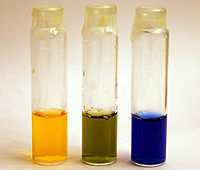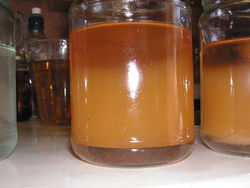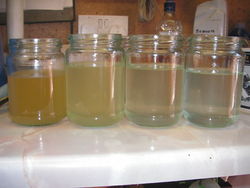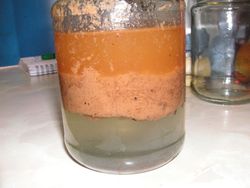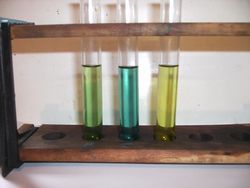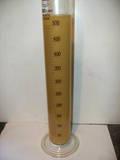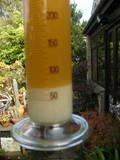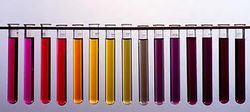Difference between revisions of "Water washing titrated acid method"
(→Removing the soaps) |
|||
| (6 intermediate revisions by the same user not shown) | |||
| Line 1: | Line 1: | ||
<metadesc>Water washing titrated method</metadesc> | <metadesc>Water washing titrated method</metadesc> | ||
| − | |||
This is a processing method which allows the biodiesel to be water washed and dried within the processor, therefore it is ideal for those with limited space who may not have the room for separate tanks needed for conventional [[water washing]]. | This is a processing method which allows the biodiesel to be water washed and dried within the processor, therefore it is ideal for those with limited space who may not have the room for separate tanks needed for conventional [[water washing]]. | ||
| − | To work effectively there needs to be a minimal amount of soap in the biodiesel prior to washing. As such, it is best used with the [[two stage process with no titration]] | + | To work effectively there needs to be a minimal amount of soap in the biodiesel prior to washing. As such, it is best used with the [[two stage process with no titration]]. |
| Line 17: | Line 16: | ||
The idea of this method is to safely water wash the [[biodiesel]] whilst still in the processor and immediately after draining the [[glycerol]], with no risk of creating an emulsion. | The idea of this method is to safely water wash the [[biodiesel]] whilst still in the processor and immediately after draining the [[glycerol]], with no risk of creating an emulsion. | ||
| − | The dreaded emulsion or ' | + | The dreaded emulsion or 'chicken Soup' is created when water and biodiesel mix in the presence of soap - this is, after all, why soap is used to wash oils and greases away with water. |
| − | Clearly if we intend to | + | Clearly if we intend to add water to [[biodiesel]] and mix vigorously with a pump then the soaps need to be removed, or turned into something else first. |
Once the soaps are gone, the biodiesel can safely be washed and the impurities drained out. However, the biodiesel will still be wet and will need to be dried before use. | Once the soaps are gone, the biodiesel can safely be washed and the impurities drained out. However, the biodiesel will still be wet and will need to be dried before use. | ||
| + | |||
| + | Where a settling tank is employed, this method negates the onerous task of periodically removing soap deposits from the tank. With the titrated acid wash method, usually all that's found at the bottom of a settling tank is residual water and either sodium or potassium sulfate in the form of an intermediate "scum" layer. If a valved drain is fitted to the settling tank, these can be occasionally drained off without the tank ever needing to be drained. | ||
==The process steps== | ==The process steps== | ||
===Producing the biodiesel=== | ===Producing the biodiesel=== | ||
The first step is to process the biodiesel by your chosen method. Whilst not essential, the [[two stage process with no titration]] method is recommended to minimise the amount of soap to be dealt with. Once as fully converted as possible, drain off all the [[glycerol]]. The fuel is now ready for the second step. | The first step is to process the biodiesel by your chosen method. Whilst not essential, the [[two stage process with no titration]] method is recommended to minimise the amount of soap to be dealt with. Once as fully converted as possible, drain off all the [[glycerol]]. The fuel is now ready for the second step. | ||
| + | |||
===Determining the amount of acid needed=== | ===Determining the amount of acid needed=== | ||
| − | [[File:Bromothymol_blue_colors.jpg |250px|thumb|right|Bromothymol blue colours | + | [[File:Bromothymol_blue_colors.jpg |250px|thumb|right|Bromothymol blue colours. Source: Wikipedia]] |
It is to carry out a [[titration]] of the fuel to ascertain the amount of acid needed to neutralise the residual chemicals and convert any soaps to free fatty acids. | It is to carry out a [[titration]] of the fuel to ascertain the amount of acid needed to neutralise the residual chemicals and convert any soaps to free fatty acids. | ||
The [[titration]] fluid needs to be a known concentration of the acid you intend to use for this process. | The [[titration]] fluid needs to be a known concentration of the acid you intend to use for this process. | ||
| − | An indicator needs to be used which will clearly show the change from | + | An indicator needs to be used which will clearly show the change from basic (alkaline) to acidic conditions around the neutral point. A suitable indicator which works very well is bromothymol blue, the colours of which are shown on the right in acidic (yellow), neutral (green) and basic (blue) conditions. |
| − | To carry out the titration, 50ml of | + | To carry out the titration, 50ml of isopropyl alcohol or methanol is placed into a beaker. A few drops of the indicator are added which should turn the solution blue. If the IPA or methanol has become acidic then the solution is 'blanked' by adding one drop of a time of 0.1% Sodium (or potassium) hydroxide solution until the solution has a blue colour). |
| − | Then 1ml of the biodiesel is added and mixed well. The solution will stay blue and may even become a stronger blue colour as the excess catalyst in the biodiesel and any soaps will be | + | Then 1ml of the biodiesel is added and mixed well. The solution will stay blue and may even become a stronger blue colour as the excess catalyst in the biodiesel and any soaps will be basic (alkaline) in nature. |
The titration fluid is then added slowly and the amount needed to just turn the mixture yellow (acidic) is recorded. | The titration fluid is then added slowly and the amount needed to just turn the mixture yellow (acidic) is recorded. | ||
This figure can be used to calculate the volume of acid needed if the strength of the titration fluid and the batch size are known. | This figure can be used to calculate the volume of acid needed if the strength of the titration fluid and the batch size are known. | ||
| + | |||
===Converting the soaps=== | ===Converting the soaps=== | ||
| − | [[File:Soap_neutralisation_washing_sample_during_first_wash.JPG |250px|thumb|right|Sample during first wash/ | + | [[File:Soap_neutralisation_washing_sample_during_first_wash.JPG |250px|thumb|right|Sample during first wash/sulfuric . Source: Julian]] |
The third step is to wash the biodiesel with the diluted acid in the processor by mixing with the pump. | The third step is to wash the biodiesel with the diluted acid in the processor by mixing with the pump. | ||
This converts the soap as follows. If using NaOH as a catalyst and sulfuric acid as a wash, sodium sulfate is produced. If using KOH with a sulfuric acid as a wash, potassium sulfate is produced. With hydrochloric acid as a wash, sodium chloride or potassium chloride are produced. | This converts the soap as follows. If using NaOH as a catalyst and sulfuric acid as a wash, sodium sulfate is produced. If using KOH with a sulfuric acid as a wash, potassium sulfate is produced. With hydrochloric acid as a wash, sodium chloride or potassium chloride are produced. | ||
| − | If using a weak acid like vinegar then this can be used neat or slightly diluted (diluting a weak acid will make it easier when draining down). If using a strong acid such as concentrated | + | If using a weak acid like vinegar then this can be used neat or slightly diluted (diluting a weak acid will make it easier when draining down). If using a strong acid such as concentrated sulfuric acid then this need to be diluted with a substantial amount of water. |
If doing this, it is VITAL that the concentrated acid is slowly added to the water. | If doing this, it is VITAL that the concentrated acid is slowly added to the water. | ||
| − | If water is added to concentrated | + | If water is added to concentrated sulfuric acid, the strongly exothermic reaction will cause the mixture to boil instantly and spit boiling acid out of the container with potentially devastating results. |
After mixing, the processor is left to settle and then the acid/water/impurities mixture is drawn off and discarded. | After mixing, the processor is left to settle and then the acid/water/impurities mixture is drawn off and discarded. | ||
It is important to take a sample immidiately before switching off the processor. This will give an idea when the mixture has settled and also confirmation that a clean split has occurred. | It is important to take a sample immidiately before switching off the processor. This will give an idea when the mixture has settled and also confirmation that a clean split has occurred. | ||
| + | |||
===Water washing=== | ===Water washing=== | ||
| − | [[File:Soap_neutralisation_washing_wash_waster_first_4_washes.JPG|250px|thumb|right|First four washes/ | + | [[File:Soap_neutralisation_washing_wash_waster_first_4_washes.JPG|250px|thumb|right|First four washes/sulfuric . Source: Julian]] |
The fourth step is to carry out one or more water washes using clean water for short mix periods. This is done until the water comes out clean after settling. | The fourth step is to carry out one or more water washes using clean water for short mix periods. This is done until the water comes out clean after settling. | ||
| Line 60: | Line 64: | ||
The picture on the right shows the progressively improving clarity of the water after each wash. | The picture on the right shows the progressively improving clarity of the water after each wash. | ||
| + | |||
| + | |||
| + | ===Draining the wash water=== | ||
| + | [[File:Acid wash interface.JPG|250px|thumb|right|Sodium sulfate from the water/biodiesel interface. Note how the wash water is comparatively clear despite the presence of a very dirty interface layer.]] | ||
| + | |||
| + | |||
| + | This method usually produces a scum like substance at the water/biodiesel interface, probably sodium or potassium sulfate depending on the catalyst used. This scum is usually evident even if the bulk of the wash water is clear. | ||
| + | |||
| + | It should be drained to a point where wet biodiesel is running clear. This mix can be set aside to separate and good biodiesel drawn off the top and included in the next batch. | ||
| + | |||
===Drying the biodiesel=== | ===Drying the biodiesel=== | ||
| − | The fifth and final step is to dry the biodiesel, | + | The fifth and final step is to dry the biodiesel. After drying, the biodiesel should be ready for use, but in practice it's preferable to let it settle in a tank for a week or so to allow any residual sodium or potassium sulfate to settle. Filtering through a fine filter will also assist removal if no settling tank is available. |
| − | + | <br> | |
| + | <br> | ||
| + | <br> | ||
| + | <br> | ||
| + | <br> | ||
| + | <br> | ||
| + | <br> | ||
| + | <br> | ||
| + | <br> | ||
| + | <br> | ||
==The chemicals needed== | ==The chemicals needed== | ||
===Solvent for titrating=== | ===Solvent for titrating=== | ||
| − | Isopropyl alcohol (IPA) or | + | Isopropyl alcohol (IPA) or methanol can be used as the base solvent for the titration tests. The biodiesel needs to dissolve into this solvent which limits the choices,if using methanol you will need to shake well and use as soon as possible. |
50 ml of this needs to be placed into a clean glass jar or beaker. The exact quantity does not appear to be critical. | 50 ml of this needs to be placed into a clean glass jar or beaker. The exact quantity does not appear to be critical. | ||
===Titration fluid=== | ===Titration fluid=== | ||
As with the titration of WVO to find the acid value, the titration fluid needs to be made of the same chemical as you will be using for the acid treatment. | As with the titration of WVO to find the acid value, the titration fluid needs to be made of the same chemical as you will be using for the acid treatment. | ||
| − | If you wish to use vinegar then the titration fluid should be vinegar diluted to a known concentration with water. If you wish to use | + | If you wish to use vinegar then the titration fluid should be vinegar diluted to a known concentration with water. If you wish to use sulfuric acid then the titration fluid should be (very) diluted sulfuric acid. |
With strong acids, a 0.1% solution (ie 1ml of acid in 1l of water) is fine. For weaker acids it may be prudent to make a stronger solution to avoid having to add large volumes to see a colour change. | With strong acids, a 0.1% solution (ie 1ml of acid in 1l of water) is fine. For weaker acids it may be prudent to make a stronger solution to avoid having to add large volumes to see a colour change. | ||
| Line 78: | Line 101: | ||
If using strong acids, always add the acid to the water, NEVER add the water to the acid. | If using strong acids, always add the acid to the water, NEVER add the water to the acid. | ||
| − | ===Indicator | + | ===Indicator solution=== |
| − | [[File: Titration_003.jpg |250px|thumb|right|Universal indicator L-R Methanol & Universal indicator,With bio added,Vinegar added. KH]] | + | [[File: Titration_003.jpg |250px|thumb|right|Universal indicator L-R Methanol & Universal indicator,With bio added,Vinegar added. Source: KH]] |
| − | An indicator is needed which will show the change point when the excess catalyst has been neutralised and the soaps converted to | + | An indicator is needed which will show the change point when the excess catalyst has been neutralised and the soaps converted to free fatty acids. |
Different indicators change at different points but what we are looking for is the sudden change in pH when the alkaline conditions are fully neutralised and the addition of any more acid causes a sudden swing to acidic conditions. | Different indicators change at different points but what we are looking for is the sudden change in pH when the alkaline conditions are fully neutralised and the addition of any more acid causes a sudden swing to acidic conditions. | ||
| − | Suitable indicators tried so far include | + | Suitable indicators tried so far include bromothymol blue, bromophenol blue and universal indicator. |
Indicators need to be in a liquid state in order that a few drops can be added to solvent base prior to the titration. | Indicators need to be in a liquid state in order that a few drops can be added to solvent base prior to the titration. | ||
| − | ===0.1% | + | ===0.1% hydroxide solution=== |
If, when adding the indicator to the solvent base, the indicator shows acidic conditions then the solvent will need to be blanked. | If, when adding the indicator to the solvent base, the indicator shows acidic conditions then the solvent will need to be blanked. | ||
| − | Achieving this requires a weak alkaline solution and the 0.1% (1g/l) solution of | + | Achieving this requires a weak alkaline solution and the 0.1% (1g/l) solution of sodium hydroxide or potassium hydroxide commonly used of the titration of WVO is ideal. This is added dropwise until the inidicator shows that the solvent is no longer acidic. |
===Acid=== | ===Acid=== | ||
| − | Perhaps the most important of the chemicals - it is the acid which removes the soaps and ultimately prevents and emulsion. Any acid can be used although there are some which are not recommended. Nitric | + | Perhaps the most important of the chemicals - it is the acid which removes the soaps and ultimately prevents and emulsion. Any acid can be used although there are some which are not recommended. Nitric acid and hydrofluoric acid are best avoided for safety reasons. |
| − | Viable acids range from | + | Viable acids range from vinegar and citric acid at the weak end of the scale to hydrochloric acid and sulfuric acid at the strongest end. |
| − | 96% Concentrated | + | 96% Concentrated sulfuric acid is readily available from most chemical suppliers & city plumbing supplies fairly cheaply and very little is needed per batch. Vinegar is very readily available and can be sourced cheaply but significantly more will be required per batch. |
| + | |||
| + | Phosphoric acid should not be used. It has been reported that this acid produces sodium phosphate which is a water soluble detergent and not conducive to the process. | ||
===Water=== | ===Water=== | ||
| Line 101: | Line 126: | ||
Secondly, water is used for the subsequent washes of the biodiesel. Normal tap water is fine for this purpose and there do not seem to be any noticeable effects from varying water hardness. | Secondly, water is used for the subsequent washes of the biodiesel. Normal tap water is fine for this purpose and there do not seem to be any noticeable effects from varying water hardness. | ||
| − | ===Example | + | ===Example vinegar method=== |
100 litre batch size | 100 litre batch size | ||
| − | [[File:Th_1stsampleunsettled_zpsbe51c872.jpg| | + | [[File:Th_1stsampleunsettled_zpsbe51c872.jpg|350px|thumb|left|Sample taken immediately after the first wash/vinegar. Source KH]] |
| − | [[File:Th_1stwashsettled_zps3b367b25.jpg| | + | [[File:Th_1stwashsettled_zps3b367b25.jpg|350px|thumb|right|First wash starting to settle/vinegar. Source KH]] |
An example method using vinegar,universal indicator and methanol as the solvent | An example method using vinegar,universal indicator and methanol as the solvent | ||
| Line 113: | Line 138: | ||
(1) Carry out a titration in this case 25 ml of methanol and universal indicator | (1) Carry out a titration in this case 25 ml of methanol and universal indicator | ||
| − | (2) Add 10 ml of bio and shake it should go from | + | (2) Add 10 ml of bio and shake it should go from green to blue |
(3) Then add the titration fluid in drips until the colour changes to green/yellow | (3) Then add the titration fluid in drips until the colour changes to green/yellow | ||
| Line 119: | Line 144: | ||
(4) Multiply the result by the batch size to get the amount of acid needed e.g. if 0.1ml vinegar used to change colour to neutralize 10ml bio, 10ml vinegar neutralizes 1L 10 x 100 L batch = 1 L vinegar | (4) Multiply the result by the batch size to get the amount of acid needed e.g. if 0.1ml vinegar used to change colour to neutralize 10ml bio, 10ml vinegar neutralizes 1L 10 x 100 L batch = 1 L vinegar | ||
| − | (5) Add to 10 litres of water and pump mix with the bio for 15 minutes,even though the vinegar is a weak acid using 10 litres of | + | (5) Add to 10 litres of water and pump mix with the bio for 15 minutes,even though the vinegar is a weak acid using 10 litres of water with it makes it easier to drain visibly |
(6) Turn off pump,close bottom valve and take sample for reference | (6) Turn off pump,close bottom valve and take sample for reference | ||
| Line 135: | Line 160: | ||
[[File: Universal_indicator.jpg |250px|thumb|centre|Universal indicator colours]] | [[File: Universal_indicator.jpg |250px|thumb|centre|Universal indicator colours]] | ||
| − | |||
| − | |||
| − | |||
| − | |||
| − | |||
| − | |||
| − | |||
| − | |||
| − | |||
| − | |||
| − | |||
| − | |||
| − | |||
| − | |||
| − | |||
| − | |||
| − | |||
| − | |||
| − | |||
| − | |||
| − | |||
| − | |||
| − | |||
| − | |||
| − | |||
| − | |||
| − | |||
Latest revision as of 12:20, 25 August 2013
This is a processing method which allows the biodiesel to be water washed and dried within the processor, therefore it is ideal for those with limited space who may not have the room for separate tanks needed for conventional water washing.
To work effectively there needs to be a minimal amount of soap in the biodiesel prior to washing. As such, it is best used with the two stage process with no titration.
Introduction to the method
In all biodiesel processes, there is a need to remove the soaps, residual processing chemicals, residual glycerol and any other impurities prior to use. This is normally achieved by either washing them out with water in the water washing process or by driving off the methanol which may or not be recovered and allowing the other products to settle out.
Both of these methods take time and extra space.
The idea of this method is to safely water wash the biodiesel whilst still in the processor and immediately after draining the glycerol, with no risk of creating an emulsion.
The dreaded emulsion or 'chicken Soup' is created when water and biodiesel mix in the presence of soap - this is, after all, why soap is used to wash oils and greases away with water. Clearly if we intend to add water to biodiesel and mix vigorously with a pump then the soaps need to be removed, or turned into something else first.
Once the soaps are gone, the biodiesel can safely be washed and the impurities drained out. However, the biodiesel will still be wet and will need to be dried before use.
Where a settling tank is employed, this method negates the onerous task of periodically removing soap deposits from the tank. With the titrated acid wash method, usually all that's found at the bottom of a settling tank is residual water and either sodium or potassium sulfate in the form of an intermediate "scum" layer. If a valved drain is fitted to the settling tank, these can be occasionally drained off without the tank ever needing to be drained.
The process steps
Producing the biodiesel
The first step is to process the biodiesel by your chosen method. Whilst not essential, the two stage process with no titration method is recommended to minimise the amount of soap to be dealt with. Once as fully converted as possible, drain off all the glycerol. The fuel is now ready for the second step.
Determining the amount of acid needed
It is to carry out a titration of the fuel to ascertain the amount of acid needed to neutralise the residual chemicals and convert any soaps to free fatty acids. The titration fluid needs to be a known concentration of the acid you intend to use for this process.
An indicator needs to be used which will clearly show the change from basic (alkaline) to acidic conditions around the neutral point. A suitable indicator which works very well is bromothymol blue, the colours of which are shown on the right in acidic (yellow), neutral (green) and basic (blue) conditions.
To carry out the titration, 50ml of isopropyl alcohol or methanol is placed into a beaker. A few drops of the indicator are added which should turn the solution blue. If the IPA or methanol has become acidic then the solution is 'blanked' by adding one drop of a time of 0.1% Sodium (or potassium) hydroxide solution until the solution has a blue colour). Then 1ml of the biodiesel is added and mixed well. The solution will stay blue and may even become a stronger blue colour as the excess catalyst in the biodiesel and any soaps will be basic (alkaline) in nature. The titration fluid is then added slowly and the amount needed to just turn the mixture yellow (acidic) is recorded.
This figure can be used to calculate the volume of acid needed if the strength of the titration fluid and the batch size are known.
Converting the soaps
The third step is to wash the biodiesel with the diluted acid in the processor by mixing with the pump.
This converts the soap as follows. If using NaOH as a catalyst and sulfuric acid as a wash, sodium sulfate is produced. If using KOH with a sulfuric acid as a wash, potassium sulfate is produced. With hydrochloric acid as a wash, sodium chloride or potassium chloride are produced.
If using a weak acid like vinegar then this can be used neat or slightly diluted (diluting a weak acid will make it easier when draining down). If using a strong acid such as concentrated sulfuric acid then this need to be diluted with a substantial amount of water. If doing this, it is VITAL that the concentrated acid is slowly added to the water. If water is added to concentrated sulfuric acid, the strongly exothermic reaction will cause the mixture to boil instantly and spit boiling acid out of the container with potentially devastating results.
After mixing, the processor is left to settle and then the acid/water/impurities mixture is drawn off and discarded.
It is important to take a sample immidiately before switching off the processor. This will give an idea when the mixture has settled and also confirmation that a clean split has occurred.
Water washing
The fourth step is to carry out one or more water washes using clean water for short mix periods. This is done until the water comes out clean after settling. The water washes do not need to be mixed for long and will settle very quickly.
The picture on the right shows the progressively improving clarity of the water after each wash.
Draining the wash water
This method usually produces a scum like substance at the water/biodiesel interface, probably sodium or potassium sulfate depending on the catalyst used. This scum is usually evident even if the bulk of the wash water is clear.
It should be drained to a point where wet biodiesel is running clear. This mix can be set aside to separate and good biodiesel drawn off the top and included in the next batch.
Drying the biodiesel
The fifth and final step is to dry the biodiesel. After drying, the biodiesel should be ready for use, but in practice it's preferable to let it settle in a tank for a week or so to allow any residual sodium or potassium sulfate to settle. Filtering through a fine filter will also assist removal if no settling tank is available.
The chemicals needed
Solvent for titrating
Isopropyl alcohol (IPA) or methanol can be used as the base solvent for the titration tests. The biodiesel needs to dissolve into this solvent which limits the choices,if using methanol you will need to shake well and use as soon as possible. 50 ml of this needs to be placed into a clean glass jar or beaker. The exact quantity does not appear to be critical.
Titration fluid
As with the titration of WVO to find the acid value, the titration fluid needs to be made of the same chemical as you will be using for the acid treatment. If you wish to use vinegar then the titration fluid should be vinegar diluted to a known concentration with water. If you wish to use sulfuric acid then the titration fluid should be (very) diluted sulfuric acid. With strong acids, a 0.1% solution (ie 1ml of acid in 1l of water) is fine. For weaker acids it may be prudent to make a stronger solution to avoid having to add large volumes to see a colour change.
To prevent issues due to local water hardness, it is prudent to use demineralised water when making the titration fluid. If using strong acids, always add the acid to the water, NEVER add the water to the acid.
Indicator solution
An indicator is needed which will show the change point when the excess catalyst has been neutralised and the soaps converted to free fatty acids. Different indicators change at different points but what we are looking for is the sudden change in pH when the alkaline conditions are fully neutralised and the addition of any more acid causes a sudden swing to acidic conditions.
Suitable indicators tried so far include bromothymol blue, bromophenol blue and universal indicator. Indicators need to be in a liquid state in order that a few drops can be added to solvent base prior to the titration.
0.1% hydroxide solution
If, when adding the indicator to the solvent base, the indicator shows acidic conditions then the solvent will need to be blanked. Achieving this requires a weak alkaline solution and the 0.1% (1g/l) solution of sodium hydroxide or potassium hydroxide commonly used of the titration of WVO is ideal. This is added dropwise until the inidicator shows that the solvent is no longer acidic.
Acid
Perhaps the most important of the chemicals - it is the acid which removes the soaps and ultimately prevents and emulsion. Any acid can be used although there are some which are not recommended. Nitric acid and hydrofluoric acid are best avoided for safety reasons. Viable acids range from vinegar and citric acid at the weak end of the scale to hydrochloric acid and sulfuric acid at the strongest end. 96% Concentrated sulfuric acid is readily available from most chemical suppliers & city plumbing supplies fairly cheaply and very little is needed per batch. Vinegar is very readily available and can be sourced cheaply but significantly more will be required per batch.
Phosphoric acid should not be used. It has been reported that this acid produces sodium phosphate which is a water soluble detergent and not conducive to the process.
Water
Water is used for two purposes in this process. Firstly, if using strong acids, it is used to dilute the acid prior to introduction to the processsor.
Secondly, water is used for the subsequent washes of the biodiesel. Normal tap water is fine for this purpose and there do not seem to be any noticeable effects from varying water hardness.
Example vinegar method
100 litre batch size
An example method using vinegar,universal indicator and methanol as the solvent
(1) Carry out a titration in this case 25 ml of methanol and universal indicator
(2) Add 10 ml of bio and shake it should go from green to blue
(3) Then add the titration fluid in drips until the colour changes to green/yellow
(4) Multiply the result by the batch size to get the amount of acid needed e.g. if 0.1ml vinegar used to change colour to neutralize 10ml bio, 10ml vinegar neutralizes 1L 10 x 100 L batch = 1 L vinegar
(5) Add to 10 litres of water and pump mix with the bio for 15 minutes,even though the vinegar is a weak acid using 10 litres of water with it makes it easier to drain visibly
(6) Turn off pump,close bottom valve and take sample for reference
(7) When the sample has settled out drain down the processor
(8) Add 20 litres of water and mix for 5 minutes
(9) Turn off pump,close bottom valve and take sample for reference
(10) Repeat steps 8 & 9 until the water is clear
(11) Dry the wet bio diesel
KH 21:32, 12 February 2013 (UTC)
